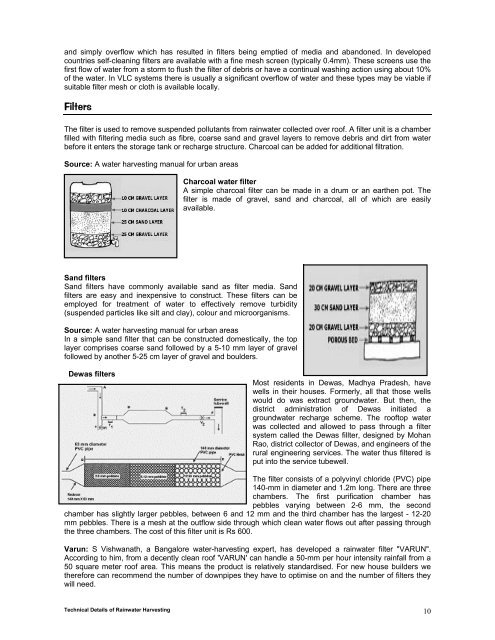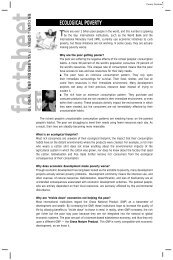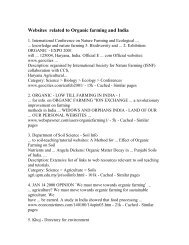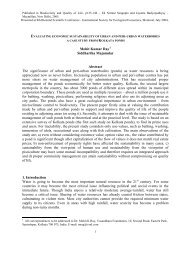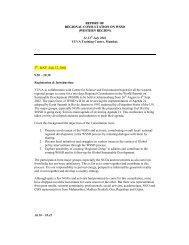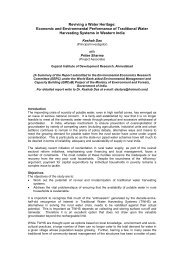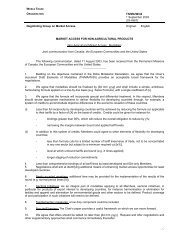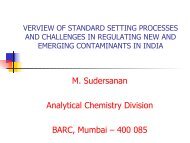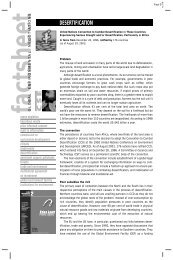Technical details - Rainwater Harvesting
Technical details - Rainwater Harvesting
Technical details - Rainwater Harvesting
You also want an ePaper? Increase the reach of your titles
YUMPU automatically turns print PDFs into web optimized ePapers that Google loves.
and simply overflow which has resulted in filters being emptied of media and abandoned. In developed<br />
countries self-cleaning filters are available with a fine mesh screen (typically 0.4mm). These screens use the<br />
first flow of water from a storm to flush the filter of debris or have a continual washing action using about 10%<br />
of the water. In VLC systems there is usually a significant overflow of water and these types may be viable if<br />
suitable filter mesh or cloth is available locally.<br />
Filters<br />
The filter is used to remove suspended pollutants from rainwater collected over roof. A filter unit is a chamber<br />
filled with filtering media such as fibre, coarse sand and gravel layers to remove debris and dirt from water<br />
before it enters the storage tank or recharge structure. Charcoal can be added for additional filtration.<br />
Source: A water harvesting manual for urban areas<br />
Charcoal water filter<br />
A simple charcoal filter can be made in a drum or an earthen pot. The<br />
filter is made of gravel, sand and charcoal, all of which are easily<br />
available.<br />
Sand filters<br />
Sand filters have commonly available sand as filter media. Sand<br />
filters are easy and inexpensive to construct. These filters can be<br />
employed for treatment of water to effectively remove turbidity<br />
(suspended particles like silt and clay), colour and microorganisms.<br />
Source: A water harvesting manual for urban areas<br />
In a simple sand filter that can be constructed domestically, the top<br />
layer comprises coarse sand followed by a 5-10 mm layer of gravel<br />
followed by another 5-25 cm layer of gravel and boulders.<br />
Dewas filters<br />
Most residents in Dewas, Madhya Pradesh, have<br />
wells in their houses. Formerly, all that those wells<br />
would do was extract groundwater. But then, the<br />
district administration of Dewas initiated a<br />
groundwater recharge scheme. The rooftop water<br />
was collected and allowed to pass through a filter<br />
system called the Dewas fillter, designed by Mohan<br />
Rao, district collector of Dewas, and engineers of the<br />
rural engineering services. The water thus filtered is<br />
put into the service tubewell.<br />
The filter consists of a polyvinyl chloride (PVC) pipe<br />
140-mm in diameter and 1.2m long. There are three<br />
chambers. The first purification chamber has<br />
pebbles varying between 2-6 mm, the second<br />
chamber has slightly larger pebbles, between 6 and 12 mm and the third chamber has the largest - 12-20<br />
mm pebbles. There is a mesh at the outflow side through which clean water flows out after passing through<br />
the three chambers. The cost of this filter unit is Rs 600.<br />
Varun: S Vishwanath, a Bangalore water-harvesting expert, has developed a rainwater filter "VARUN".<br />
According to him, from a decently clean roof 'VARUN' can handle a 50-mm per hour intensity rainfall from a<br />
50 square meter roof area. This means the product is relatively standardised. For new house builders we<br />
therefore can recommend the number of downpipes they have to optimise on and the number of filters they<br />
will need.<br />
<strong>Technical</strong> Details of <strong>Rainwater</strong> <strong>Harvesting</strong> 10


